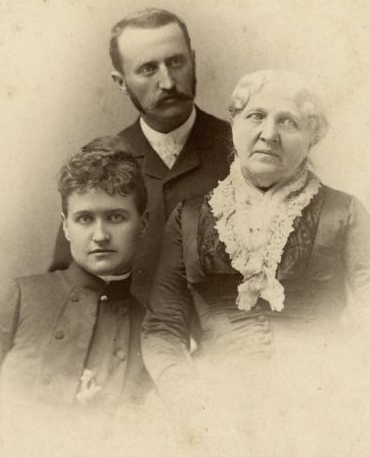Encyclopedia Dubuque
"Encyclopedia Dubuque is the online authority for all things Dubuque, written by the people who know the city best.”
Marshall Cohen—researcher and producer, CNN
Affiliated with the Local History Network of the State Historical Society of Iowa, and the Iowa Museum Association.
SCIDMORE, George H.
Ancestry: https://www.ancestry.com/discoveryui-content/view/4564364:60541
SCIDMORE, George H. (Dubuque, IA, Oct. 12, 1854--Yokohama, Japan, Nov. 27, 1922). Scidmore entered government service soon after earning his law degree. He was stationed in Liverpool, England in 1877. Shortly after his admission to the bar young Scidmore was appointed consular clerk (a position now referred to as consular assistant). Liverpool was a shipping port of importance, and Scidmore always referred to his stay there with much pleasure. He learned ships and shipping at first hand. Disputes had to be settled on the spot; there was no cabling for instructions, and his deep familiarity with Admiralty law and maritime practice were largely due, he stated, to the training he received there. (1) In 1877 he was placed in charge of the Consular agency at Dunfermline, Scotland, as Vice Consul, remaining there until July 5, 1878, when he was assigned to duty at the Consulate Generalat Paris. It was during his stay at Paris that he first became aware of the telephone, to which he always had an aversion that amounted at times to active hostility. He claimed that he had been made telephone-shy by an exhibition instrument that was installed in his office without his knowledge. He stated that he never recovered from the shock of having a raucous bell ringing in his ears, followed by a flood of French directed in and out of the contraption. (2)
In 1907, when he was appointed Consul at Nagasaki, Japan. He was one of thirteen whom President Grant and Secretary Fish are said to have referred to as Consular Cadets, in the hope that they were the nucleus of a civil service that would serve the country in a manner similar to military and naval officers. He held various positions before being named U.S. Deputy Consul General in Kanagawa, 1897; and Yokohama, 1902. As vice consul-general of the United States at Kanagawa, Japan, he accepted a medal conferred upon him by the Emperor of Japan for saving a subject of Japan from death by drowning on March 2, 1891. (3)
With the reorganization of the U.S. consular system in 1906, the method for selecting consuls was drastically changed. Consuls were chosen from a pool of foreign service officials who had already established themselves through prior diplomatic service -- more often than not in Japan.
The first person to be assigned to Nagasaki after the 1906 reforms was George H. Scidmore, a long-time official at the U.S. Consulate at Yokohama. He served as the U.S. Consul General in Yokohama from 1914-22. During this time he published Consular Jurisdiction in Japan, which became a manual for practicing attorneys in the Consular Courts. Scidmore was also allowed to engage in the private practice of law at Yokohama and became recognized as one of the leading lawyers of the Far East, practicing before the British as well as in the Consular Courts. Skidmore related an amusing incident in his career as a practicing lawyer which, he claimed, showed the danger of writing a book. He was pleading in a civil suit before the British Consular Court when his opponent asked the judge if the “learned counsel” on the other side was not a recognized authority in matters of law. When judge replied in affirmatively, the opposing attorney then quoted “Consular Jurisdiction” to the detriment of Scidmore’s client. “After that,” Mr. Scidmore used to say, “I earned more fees by keeping my legal knowledge out of print and my clients out of court.” (4)
Scidmore's sister, Eliza, was an American writer, photographer, and geographer who often accompanied her brother on his travels. Upon their return to Washington, D. C. in 1885, she had her famous idea of planting Japanese cherry trees in the nation's capital. ElizA Scidmore in 1923 became the first female board member of the National Geographic Society. (5)
---
Source:
1. Neville, Edwin L. "American Consular Bulletin," Vol. 5 No. 2, February, 1923, p. 33
2. Ibid., p. 34
3. United States Statutes at Large Volume 26.djvu/51. Online: https://en.wikisource.org/wiki/Page:United_States_Statutes_at_Large_Volume_26.djvu/51
4. Neville, p. 56
5. Mauzé, Marie; Harkin, Michael Eugene; Kan, Sergei (2004). Coming to Shore: Northwest Coast Ethnology, Traditions, and Visions. University of Nebraska Press. p. 206.


